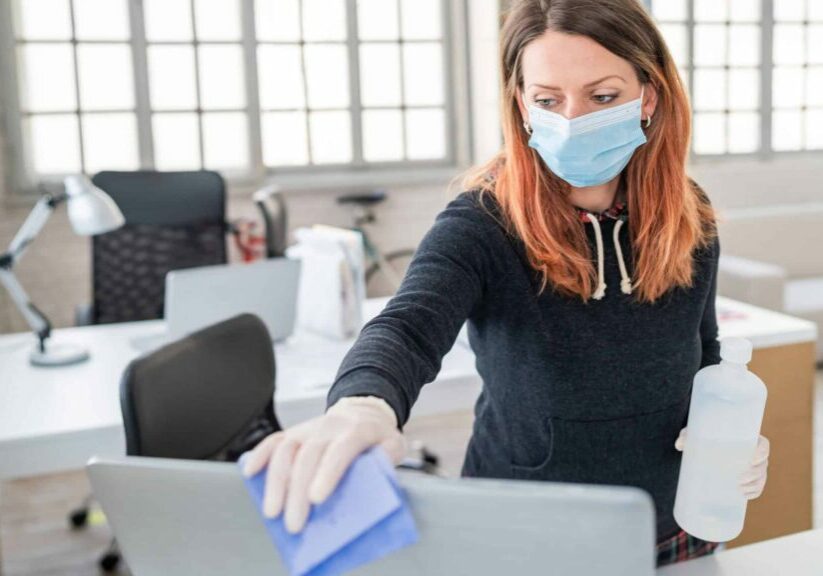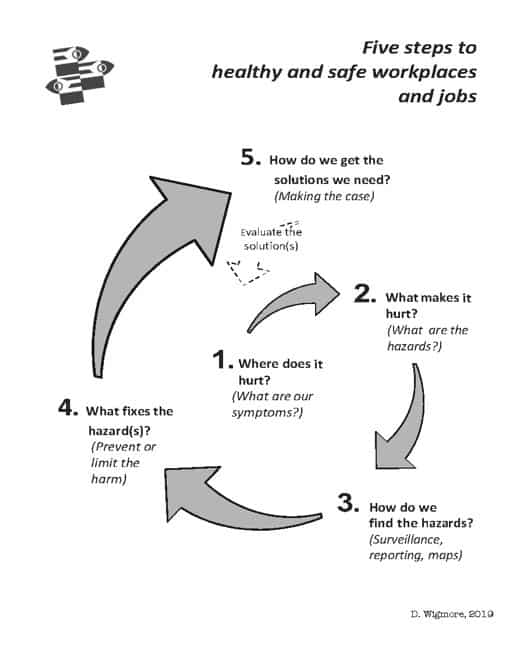By Dorothy Wigmore
Indoor air quality. Mold. Toxic chemicals. The pandemic.
Most school staff face occupational health and safety (OHS) hazards, affecting their physical and mental health, spirits and job satisfaction.
Union health and safety committees (HSCs) are an essential tool to organize members to deal with those hazards. Separate from joint labor-management committees, they make issues visible, lend credibility to members’ voices, and improve working conditions, while developing leaders. They protect individuals, providing a unified voice based on shared tasks, knowledge and learning.
“The only way boards and superintendents hear our voices is when we get involved,” says Shawn Dudley, president of the Washington Township Schools Support Services Personnel Association. “It’s a way to push the issue collectively rather than have repercussions for someone doing it alone.”
In 2016, his association set up an HSC with the teachers and secretaries association, the Washington Township Education Association, to tackle mercury in rubberized floors. Alerted by a Review article and helped by the New Jersey Work Environment Council (WEC), they reviewed documents, attended board of education meetings and recruited public support. The result: a huge victory to replace the flooring.
Who’s on a committee?
NJEA UniServ field reps and local leaders can help set up an HSC. Include representatives of all school staff. Diverse backgrounds (e.g., race, gender, job description) bring different ways to reach members, find hazards and propose solutions benefiting everyone affected.
How to begin?
Committees often start around one issue, says Andrew Lewis, the vice president of the Old Bridge Township Education Association and a part-time NJEA organizing consultant in the central region.
“You often go in thinking there’s one issue and then you discover there are ten,” Lewis says. “After basic training, members can figure out which three or four are most likely to be fixed first. A roof is a bigger ask, so it may not be the first thing. Starting with items you think are winnable builds confidence to tackle harder problems later.”
Whatever happens with the pandemic, he adds, other issues won’t go away.
“Mold is not going to go away,” Lewis says. “Mercury in gym floors won’t go away. There are still things that need to be addressed after this is done.”
However it begins, local leadership needs to be on board. They can support new committees getting training and time for learning and doing things. Members need:
- To learn how to listen and ask open-ended questions (the committee needs stories, not “yes” or “no” answers).
- Criteria and tools to set priorities, research and distinguish solutions (goals) from strategies (how to reach the goals).
- Training and tools to deal with conflicts, including disagreements with administration.
- Awareness of how racism, sexism and other discriminatory behaviors affect what people do and what they say or don’t say.
Training topics should cover OHS principles, hazard categories, preferred solutions, workers’ rights, and relevant legislation and policies. Information gathering needs to be practiced. Research skills need to be honed.
The processes should emphasize member participation with collective action and solutions. Visual tools like body and workplace maps are fun, gather information and provide overviews and connections.
What can committees do?
Use the five steps for healthy and safe workplaces (see graphic).
1. Where does it hurt? Start with members’ experiences. Listen, question, follow up, to find out about current and possible health effects. With body maps, members see patterns, learn they’re not alone, tell stories.
2. What makes it hurt? Always consider the six hazard categories (see graphic). “Safety” is the most visible, but it’s not “health.” Health effects usually are harder to connect to work. Hazards can overlap.
3. How do you find symptoms/hazards?
-
- Check district illness and injury logs, sometimes called “300 Logs.” Organize body mapping by building, area, or job. Compare and analyze results. Survey members using tools, such as NJEA’s Indoor Air Quality Occupant Survey or StressAssess. Found at https://stressassess.ca, this is an app for individuals and online for organizations.
- Have groups draw and analyze workplace maps for all hazard categories.
- Review district OHS documents and practices. Compare them to Public Employees Occupational Safety and Health (PEOSH) requirements and other recommendations.
- Check your contract.
- Investigate when people have health issues or are injured.
- Use collected information for walk-throughs/inspections, looking at all hazard categories and how “rules” or recommendations are followed. Take notes and photos.
- Put “results” on maps. Compare them to members’ body and workplace hazard maps.
4. What fixes the hazards? Apply principles: prevention/elimination first, followed by informed substitution. Personal protective equipment (PPE) is the last resort if there is no other way to remove or reduce the hazard. PEOSH rules are starting points. Develop short-, medium- and long-term solutions.
5. How do you get the “fixes” you need?
-
- Brainstorm strategies for each solution.
- Figure out what the problem costs (e.g., indirect costs to individuals, families, school/district, community).
- Who benefits? How?
- Use the contract. What changes are needed?
- Involve members, leaders and UniServ reps in brainstorming solutions and strategies. Enlist parents, students, the media, etc.
- Determine if and how to use PEOSH.
“You can’t just present problems,” Dudley says. “You’re more likely to be taken seriously if you have solutions. And more members come to the committee then.”
Dorothy Wigmore is a long-time health and safety specialist, trained in occupational hygiene, ergonomics, “stress” and education. A Canadian, she has worked also in the U.S. and Mozambique. Her focus is on solving job-related hazards through prevention and worker participation.
Lesson leaned by HSCs
- It’s more than meetings.
- Educate yourselves and others, without becoming “experts.”
- Document and research.
- Listen to members and keep them informed
- Mobilize your influence (organize).
- Build trust and solutions.
- Address authority, being assertive and persistent.
- Use official documents.
- Use the law strategically and creatively.
PEOSH’s specific standards
- Indoor air quality
- Sanitation
- Hazard communication (right-to-know)
- Bloodborne pathogens
- Lead
- Asbestos
- Electrical lockout
- Confined space entry
Employers must have written programs about:
- Hazard communication
- Asbestos Hazard Emergency Response Act (AHERA)
- Integrated pesticide management (IPM)
- Fire and evacuation
- Emergency response
- School safety and security
- Confined space entry
Resources
Labour Occupational Health Clinics Academic Research Collaboration (LOARC)
Health and Safety representation: Writing the Workers Back In
NJEA, Health and safety manual, other OHS materials
njea.org/issues/health-safety/health-safety-publications
PEOSH
Wigmorising
“Seeing the Workplace with New Eyes”
wigmorising.ca/seeing-jobs-with-new-eyes
New Jersey Work Environment Council
Healthy Schools Now coalition

